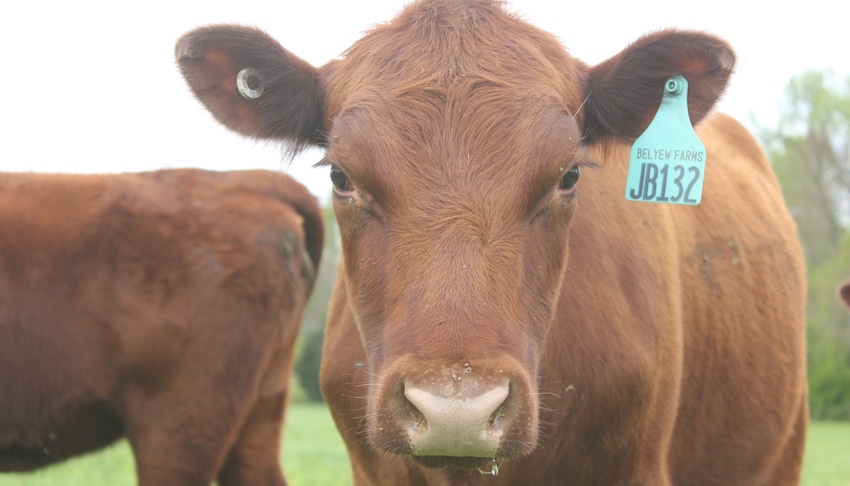
Don’t wait for the train wreck.
That’s what Kelsey Harvey told ranchers gathered at the North Mississippi Beef Expo as she outlined the importance of mineral nutrition and supplementation to herd health and reproduction rates. Harvey, an assistant professor with the Department of Animal and Dairy Sciences at Mississippi State University, said mineral requirements for cattle are sometimes misunderstood and often ignored. That is, until a producer observes one of those train wrecks on his farm, such as poor pregnancy rates, poor calf gains and increased mortality.
“If you are not addressing mineral nutrition until after one of these catastrophes occurs, it’s going to take long time to restore your herd health,” Harvey said. “Ensuring adequate mineral nutrition up front will have long-term impacts. Know the requirements. Know the mineral content of feeds, and supplement what is necessary.”
Harvey stressed that mineral deficiencies often begin during gestation. This can create unintended long-term consequences for beef cattle operations — particularly those retaining replacement heifers. Research has shown that maternal nutrient status during pregnancy affects the lifetime productivity of female calves by impacting ovarian reserves. Today’s mineral-deficient cow could affect herd pregnancy rates for years to come.
Trace minerals
Trace minerals such as copper, zinc, selenium, iodine and manganese are present in only minute amounts in a cow’s diet, but they can be just as important as macro minerals such as calcium or phosphorus.

“A misconception is that it’s ok to be deficient in one or two of the trace minerals if the rest of the essential minerals are in adequate supply, but that’s simply not true,” Harvey said. She used the “hole in the bucket” analogy to explain how a deficiency in one part affects the entire outcome.
“Minerals interact with each other and trace minerals impact cattle’s intake and absorption of other minerals. Each mineral is vital,” she said.
Harvey said selenium is the most deficient trace mineral in Mississippi forage-based cattle diets. Signs of selenium deficiency include retained placenta, uterine infections, and reduced fertility. Calves born with selenium deficiency may be slow to stand and nurse. Like with all minerals, there are toxic effects of consuming too much selenium, but deficiency is much more prevalent. However, Harvey added there is no evidence that selenium requirements should exceed 0.3 ppm of dry matter intake.
Supplementing during gestation
Earlier this year, Harvey published an article on supplementing trace minerals to gestating cows in the scientific journal Animals. Her investigation found that supplementing beef cows with organic compound sources of cobalt, copper, manganese and zinc enhanced passage of zinc and copper to fetal tissues and resulted in life-long effects in the health and productivity of offspring. For example, heifers born to cows receiving trace mineral supplements reach puberty faster.
Another reason for supplementing during gestation — calves need a higher body reserve than adults.
“Calves are losing minerals the minute they hit the ground,” Harvey said. “And in those first days when their diets are mostly milk, those minerals are not being replenished. If the mother is deficient during pregnancy, the calf receives even less, and begins its life with insufficient nutrients.”
Mineral supplementation methods
Free-choice, salt-based supplements are the most common method of supplementation, and Harvey said they are effective in most grazing situations. She cautions that producers pay attention to fluctuations in herd salt cravings, which tend to go down in the winter and spring months — a time when the need for trace minerals may be greatest.
“Offering protein and energy supplements that are fortified with minerals is an excellent way to deliver trace minerals to grazing cattle when forage quality and quantity are suboptimal,” Harvey said. “There’s typically less variation compared to loose mineral mix supplements, but attention should be paid to animal dominance and bunk space when feeding.”
“Trace mineral injections are a convenient way to address mineral needs, but should not replace traditional supplementation programs,” Harvey said. “Injections should be used as a tool to improve mineral status of cattle prior to challenging events, such as calving, weaning or breeding.”
Applying trace minerals as fertilizers to plants or as soil amendments is a new advancement. The process known as biofortification, has shown promise, particularly in addressing selenium deficiencies, according to Harvey, but research is limited.
Forage testing
Forage testing can be a useful tool in both maximizing animal production and minimizing costs associated with mineral supplementation. Harvey said forage testing may be particularly important this year, as producers forego fall fertilization of pastures due to rising fertilizer prices.
“Any changes you make to management practices could cause changes in the mineral content of your forages,” Harvey said. “A forage test is a good way to assess the mineral content of your forage, so you can supplement what is necessary and only what is necessary.”
About the Author(s)
You May Also Like






